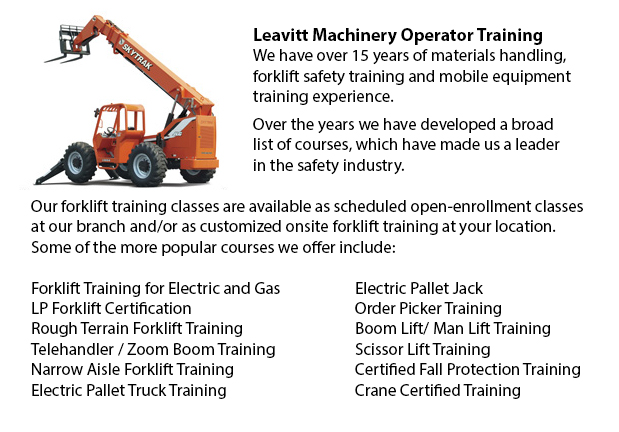
Zoom Boom Training Vancouver - Zoom Boom Training is intended to train operators on variable reach forklifts. The goals of the training are to be able to impart an understanding of the physics of the equipment, and to be able to outline the operator's tasks. This course abides by North American safety standards for lift trucks. Zoom boom training and certification is accessible at our site or at the company's location, provided there are a minimum number of trainees. Certification received upon successfully finishing it is valid for three years.
The telehandler or telescopic handler is similar in various ways to a common forklift or a crane. This helpful machinery is constructed along with a telescopic boom which could extend forward and lift upwards. Various attachments could be connected on the end of the boom, like bucket, pallet forks, lift table or muck grab. It is popular in agriculture and industry settings.
Telehandlers are most normally used along with the fork attachment to transport loads. The units have the advantage that they could get to places not accessible to regular forklifts. Telehandlers are capable of removing palletized loads from within a trailer and placing them on high places such as rooftops. For certain applications, they could be more practical and efficient than a crane.
When lifting loads which are heavy, the telehandler could experience some instability. As the boom is extended too far with a load, the equipment will become more unsteady. Counterweights in the rear help, but do not solve the problem. The lifting capacity rapidly decreases as the working radius increases. Various equipment come with front outriggers that extend the lifting capacity when the machinery is stationary.
To determine whether a load is too heavy, the operator could check with the load chart. The factors covered in the calculation includes load weight, boom angle and height are calculated. Some telehandlers have sensors which cut off further control or provide a warning if the unit is in danger of destabilizing.
-
Telehandler Ticket Vancouver
Telehandler Ticket Vancouver - The telescopic handler or telehandler is a frequently used equipment in agricultural and industrial applications. This equipment is similar in appearance to a forklift and also functions in a similar way, even if teleha... More -
Forklift Operator Certification Vancouver
Forklift Operator Certification Vancouver - Forklift operator certification is usually needed for employees working within industrial, warehouse or construction environments to guarantee the safe operation of forklifts. Workplace training need to fol... More -
Certified Fall Protection Training in Vancouver
There are high numbers of injuries at work linked to falling and a lot of fall-related deaths reported each and every year. The majority of these instances might have been avoided with better training, better measures in place, and by correctly equip... More -
Forklift Training Course Vancouver
Forklift Training Course Vancouver - CSA and OSHA establish criteria for forklift safety training which meets existing standards and regulations. Anyone planning to utilize a forklift is needed to successfully complete safety training prior to using... More -
Overhead Crane Certification Vancouver
Overhead Crane Certification Vancouver - The overhead crane certification course is a program that is designed to assist trainees, even if they have literacy or language restrictions. The course comprises a practical hands-on training session and a c... More -
Forklift Instructor Training Vancouver
Forklift Instructor Training Vancouver - Forklift Instructor training certification is recommended for forklift operators who would like to become instructors. To qualify for forklift instructor training, operators must be able to prove they possess... More -
Crane / Overhead Crane / Truck Mounted Crane / Hydraulic Cranes Training in Vancouver
Overhead cranes are likewise referred to as bridge cranes. They are actually a type of crane which comprises a hook and line apparatus which runs along a horizontal beam which runs along two widely separated rails. Lots of overhead cranes can be foun... More -
Scissor Lift Safety Training Vancouver
Scissor Lift Safety Training Vancouver - A scissor lift is a kind of platform lift that moves vertically. The lift table is moved in a vertical motion because of criss-cross folding supports which are linked in what is referred to as a pantograph. Th... More

Forklift Training Vancouver
TOLL FREE: 1-888-254-6157
24389 Fraser Highway
Langley, British Columbia
forklifttrainingvancouver.com
Email Us
About Us


